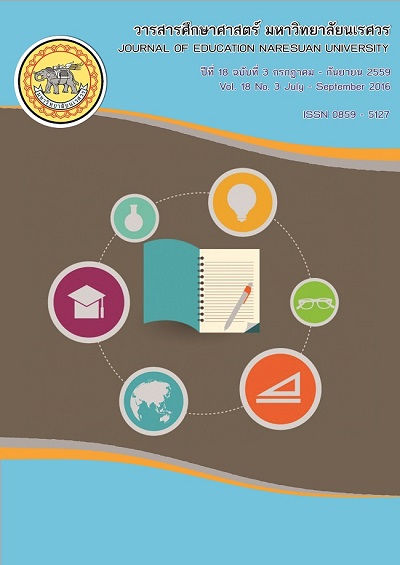รูปแบบการเสริมสร้างความผูกพันของครูในสถานศึกษา สังกัดสำนักงานเขตพื้นที่การศึกษาประถมศึกษา
Main Article Content
Abstract
การวิจัยครั้งนี้มีจุดประสงค์เพื่อ พัฒนารูปแบบการเสริมสร้างความผูกพันของครูในสถานศึกษา สังกัดสำนักงานเขตพื้นที่การศึกษาประถมศึกษา มีขั้นตอนการวิจัย 3 ขั้นตอน 1) เพื่อศึกษาองค์ประกอบและแนวทางการเสริมสร้างความผูกพันของครูในสถานศึกษา ใช้วิธีสังเคราะห์เอกสารและสัมภาษณ์ผู้เชี่ยวชาญ จำนวน 16 คน 2) เพื่อสร้างและตรวจสอบรูปแบบการเสริมสร้างความผูกพันของครูในสถานศึกษา โดยนำผลการศึกษาจากขั้นตอนที่ 1 มาใช้ยกร่างแล้วตรวจสอบความเหมาะสมโดยการประชุมระดมความคิดของผู้ทรงคุณวุฒิ จำนวน 9 คน 3) เพื่อประเมินความเป็นไปได้ และความเป็นประโยชน์ของรูปแบบการเสริมสร้างความผูกพันของครูในสถานศึกษา สังกัดสำนักงานเขตพื้นที่การศึกษาประถมศึกษา โดยการประชุมประชาพิจารณ์ของผู้ทรงคุณวุฒิ จำนวน 60 คน ผลการวิจัยปรากฏ ดังนี้
1. รูปแบบการเสริมสร้างความผูกพันของครู มีองค์ประกอบ 2 ส่วน ได้แก่ 1.1) องค์ประกอบความผูกพันของครูในสถานศึกษา มี 4 องค์ประกอบย่อย คือ ความผูกพันของครูต่อสถานศึกษา, ต่อนักเรียน, ต่อวิชาชีพ, และต่อชุมชน 1.2) องค์ประกอบการเสริมสร้างความผูกพันของครูในสถานศึกษา ซึ่งเป็นแนวทางการเสริมสร้างความผูกพันของครูในสถานศึกษา มี 3 ระดับ คือ ระดับองค์การ ประกอบด้วย การบริหารองค์การ มีแนวทางในการดำเนินงาน 4 ด้าน คือ นโยบาย วิสัยทัศน์ กลยุทธ์, โครงสร้างระบบงานที่ชัดเจน และเหมาะสม, สภาพแวดล้อมที่เอื้อต่อการปฏิบัติงาน และระบบเทคโนโลยีสารสนเทศและการสื่อสาร การบริหารทรัพยากรมนุษย์ มีแนวทางในการดำเนินงาน 4 ด้าน คือ การสรรหาบุคลากร, การวางแผนงานบุคลากร, การพัฒนาบุคลากร, และการธำรงรักษาบุคลากร ระดับกลุ่ม มีแนวทางในการดำเนินงาน 3 ด้าน คือ การพัฒนาทีมงาน, การสื่อสารหลายทาง และการสร้างชุมชนแห่งการเรียนรู้ ระดับบุคคลมีแนวทางในการดำเนินงาน 2 ด้าน คือ คุณลักษณะและพฤติกรรมของผู้บริหาร และคุณลักษณะและพฤติกรรมของครู
2. ผลการประเมินรูปแบบการเสริมสร้างความผูกพันของครูในสถานศึกษา สังกัดสำนักงานเขตพื้นที่การศึกษาประถมศึกษา มีความเป็นไปได้ในการนำไปใช้อยู่ในระดับมากและมีความเป็นประโยชน์ในการนำไปใช้อยู่ในระดับมากที่สุด
MODEL OF ENHANCING TEACHERS’ COMMITMENT TO SCHOOL UNDER THE PRIMARY EDUCATIONAL SERVICE AREA OFFICE
This research aimed to develop a model for enhancing teachers’ commitment to schools under the Primary Educational Service Area Offices. The research was divided into three steps. The first step was to elicit the elements and approaches to enhancing the teachers’ commitment by synthesizing related documents and interviewing sixteen experts. The second step was to establish and examine the model for enhancing the teachers’ commitment by applying the results found in the first step as a model framework and verifying the model appropriateness focus group discussion among nine experts. The last step was to assess the feasibility and benefits of the model for enhancing the teachers’ commitment to schools by holding a public hearing with sixty experts. The results of the study are as follows:
1. Four factors enhancing teachers’ commitment are commitment to schools comprising three aspects, commitment to students with five aspects, commitment to the teaching profession with four aspects, and commitment to community with three aspects.
2. The factors enhancing teachers’ commitment to school are divided into three levels, namely 2.1) the organizational level, which comprises four areas: policy vision, strategy, clear-cut and appropriate organizational structure, as well as environments conducive to implementation, information technology and communication; the human resource management consists of four aspects: selection of personnel, planning for personnel management work, personnel development, and personnel retention; 2.2) the group level, which deals with three aspects of operation comprising the development of team work, a multi-faceted communication system, and the creation of professional learning community; and 2.3) the individual level, which is carried out in two aspects, namely the qualifications and behavior of the administrator, and those of teachers.
3. Results of the assessment of the model of enhancing teachers’ commitment to school under the primary educational service area office indicated the feasibility at the higher and highest levels of benefits in application.
Article Details
The owner of the article does not copy or violate any of its copyright. If any copyright infringement occurs or prosecution, in any case, the Editorial Board is not involved in all the rights to the owner of the article to be performed.


